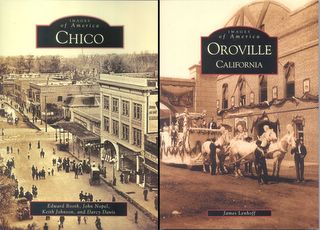
Retired Oroville teacher tells story of a daughter lost, a family united in tragedy
By DAN BARNETT
"I love young babies," writes Olivia Claire High, who retired in 1997 after 19 years teaching in Oroville elementary schools. "They come from their special little cloistered world, with their own unique chemistry. There's a certain mystery about them that intrigues me. I can't help wondering what goes on inside their pure little minds when I see the myriad of expressions flitting across their tiny faces."
When their first daughter, Kathy, was born to Claire and her husband Joe in 1958, Claire was a young married, "barely 19," "a 'color inside the lines' kind of person" who liked "to plan each page of my life as much as I possibly can." But plans go awry. Kathy was born with a cleft lip.
But surgery repaired the damage early on, and Claire welcomed their second daughter, Kari Suzanne, born in 1960, hoping that lightning would not strike twice. Yet during Kari's infancy Claire would have a recurring nightmare of her death. Kari lived 6 years, the last three battling an especially aggressive form of leukemia, a story her mother could not recount until now, all these many years later.
"An Angel Among Us: A Mother's Heartfelt Story" ($16.95 in paperback from I & L Publishing in Oroville, www.ilpublishing.com) presents not only Kari's physical struggle but her mother's spiritual struggle as well. "I kept trying to figure out why this awful thing was happening. The more I probed, the less I understood. Why was God letting this happen to Kari? Was it my fault? Was He punishing us? Was He trying to teach us a lesson? I couldn't find one convincing reason to justify any of this intolerable heartache we were going through. It would have been so easy to turn away from God, but I couldn't because I needed His spiritual sustenance. Still, it wasn't easy walking through the minefield of events laid down by Kari's illness."
There was no miraculous recovery for Kari though her illness frequently went into remission. Her reaction to multiple-drug therapy often made matters worse. Trips from Oroville to the UC Medical Center in San Francisco became all-too-routine and the companionship of other families with severely ill children was bittersweet. Who would succumb next?
Most of the book is a detailed record of Kari's struggle and the reader almost wants to turn away in the face of such suffering. A published story about the book noted that Claire had kept a journal since her teenage years, something to draw on when hazy memory begins to play tricks. But it is clear that Claire High's story is not self-pitying. The writing is straightforward, the evidence of some emotional distance. "Joe and I feel so fortunate these days," she writes toward the end of the book. "We have three loving daughters who share our lives. We still think about Kari and will always wish that she could still be here with us in body, as well as spirit. ... She seems to be in my thoughts more now that I'm getting older. I've tried to make some sense out of why Kari had to suffer so much, but I don't think I ever will. I'll always think of leukemia as a thief. It is a robber of life and happiness, of futures and dreams. I do not spend my days wallowing in bitterness, but the sadness is there. My heart still feels the pain of my daughter's ordeal, but I can't dwell on it because I have so much to be thankful for."
Not long before she died Kari whispered to her mother, "Take care of Cuddles for me." Cuddles, a miniature poodle, had been a constant companion in her last year. Those words would prove to be Kari's last. "She passed away the next morning; it was Joe's 35th birthday. Her life's brief journey had come to an end."
More than a dozen black-and-white photographs enhance the poignancy of the story.
"Kari enriched our lives with her presence," Claire writes, "but she was a precious little gem we were not meant to keep. It's very hard not to miss someone you've loved so much. You have your memories, but they are not flesh and blood you can hold in your arms, nor do they give you the sound of their laughter. Only the cherished echoes remain."
Dan Barnett teaches philosophy at Butte College. To submit review copies of published books, please send e-mail to dbarnett@maxinet.com. Copyright 2006 Chico Enterprise-Record. Used by permission.


